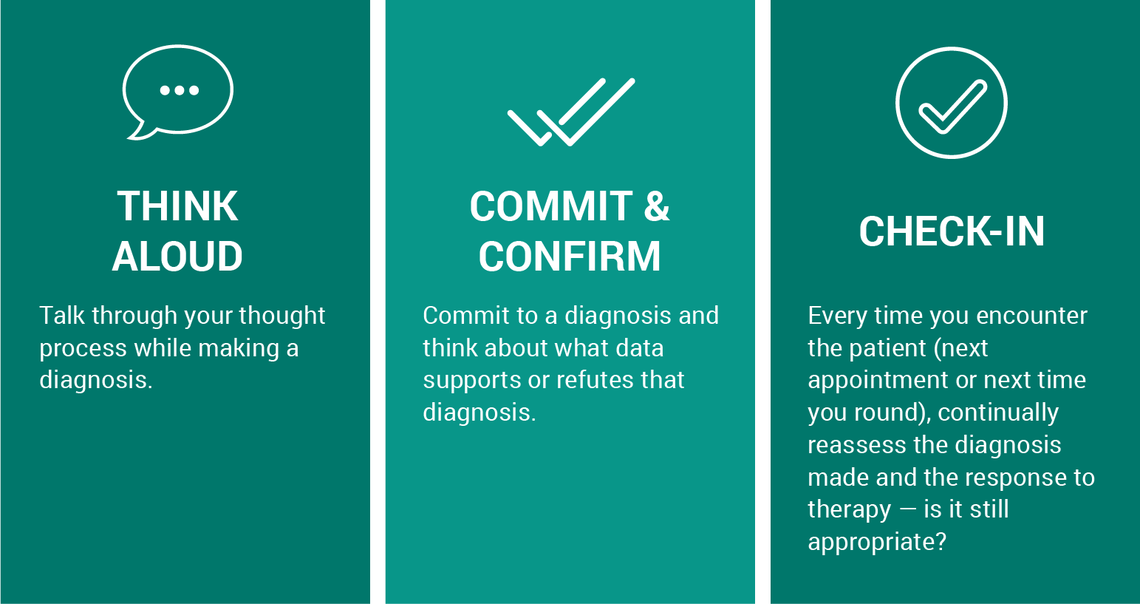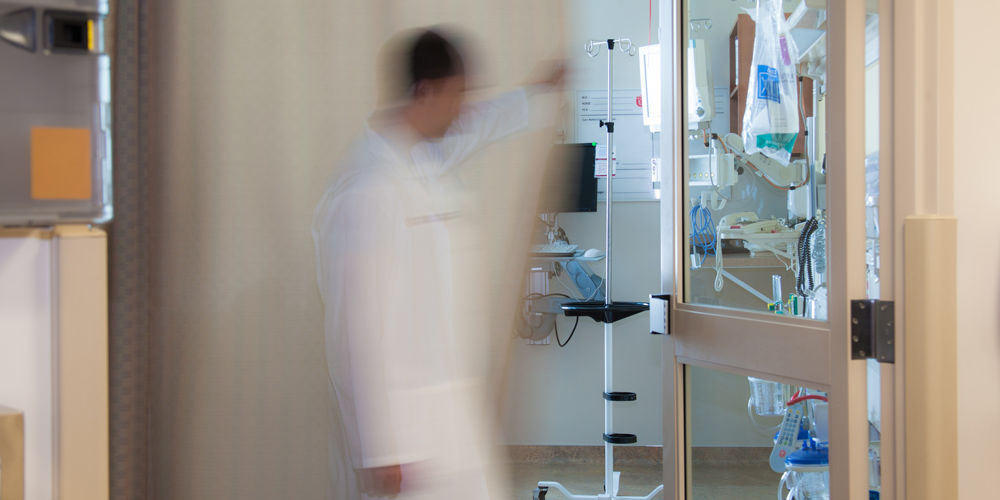Learning Objectives:
After reading this article, you will be able to:
(1) explain why diagnostic error is a problem, and (2) apply strategies to prevent diagnostic error at both the individual provider and system-level.
Download Slides: PPT
Case Study
Mr. Pauls had pneumonia–or so it seemed. The 90 year old patient did not have leukocytosis or abnormal chest x-ray, however, given his dementia, recurrent aspiration, and cough, pneumonia seemed likely. But after two days of antibiotic therapy, his clinical condition hadn’t changed. The team decided to pursue further evaluation and he was found to have an acute pulmonary embolism. In retrospect, this diagnosis actually made more clinical sense. What happened here?
What is diagnostic error?
In its 2015 report Improving Diagnosis in Health Care, the Institute of Medicine (IOM) defines diagnostic error two ways: (1) “The failure to establish an accurate and timely explanation of the patient’s health problems” or (2) “The failure to communicate that explanation to the patient.”
The second part of that definition aligns with patient-centered care and the patient perception of error. Every week, U of U Health system receives nearly The Five Elements of Patient Experience from patients. Sometimes patients describe diagnostic errors–an incorrect test that leads the patient to return to get retested, incorrect medications, at times, diagnoses that turn out to be wrong.
Patients describe these experiences as scary and often confusing. When an error occurs, it not only affects a patient’s trust and confidence in their provider, but also reduces trust in the entire health care system.
Impact of diagnostic error
Why is this important? Most of us will experience a diagnostic error in our lifetime. A missed diagnosis can delay important treatment or result in inappropriate treatment, often causing patients unnecessary physical pain, psychological suffering, and financial hardship.
Understanding why diagnostic errors happen is harder. Much of the research on this subject has focused on cognitive errors, which contribute to 74% of diagnostic errors. Faulty knowledge or skill was much rarer, accounting for less than 4% of diagnostic errors.
How do we prevent diagnostic error?
There are two primary recommendations for preventing diagnostic errors: provider-based recognition of cognitive errors (common biases and influence our thinking) and system-based approaches.

For more information, visit this exceptional four-part series on common cognitive errors in medicine from First10EM.
1. Provider-based approaches
Making a diagnosis typically involves a combination of analytical thinking and non-analytical thinking—recognizing patterns or applying mental shortcuts called heuristics. Each mode of thinking is prone to error; recognizing and attempting to mitigate the most common types of errors may then reduce diagnostic error.
Be aware of common biases that influence decision making. Our case study is an example of premature closure, the most common type of cognitive error that occurs when a diagnosis is made and thinking stops. This can result in the failure to consider additional tests and diagnoses. Contributing factors to premature closure include confirmation bias (seeking information to support an initial diagnosis rather than thoroughly evaluating additional data, availability bias (tending to diagnose diseases recently seen, and base rate neglect (neglecting prevalence of disease when considering diagnosis).
Be consistent in decision making. Perpetual high alert is not a strategy. The following strategies may help to avoid diagnostic error:

- Think aloud: Talking through your thought process while making a diagnosis.
- Commit and confirm: Commit to a diagnosis and think about what data supports or refutes that diagnosis.
- Check-in: Every time you encounter the patient (next appointment or next time you round), continually reassess the diagnosis made and the response to therapy—is it still appropriate?
2. System-based approaches
Consistent with quality improvement and patient safety principles, addressing diagnostic error requires multiple areas of focus. At the system level, creating and reinforcing a no-blame culture of continuous improvement helps providers and teams evaluate diagnoses and learn from missed diagnoses.
Build a no-blame culture. The historical shame-and-blame culture of medicine applies individual blame to errors, instead of identifying and addressing system-based improvements. One study indicated that only half of physicians in training thought that errors were handled appropriately at their institution; nearly a third thought they would be criticized for making mistakes. One goal of patient safety is to create a culture committed to addressing concerns, respecting all parties involved, and creating an environment where people are comfortable drawing attention to medical errors.
Report diagnostic errors to prevent future errors. A cornerstone of safety culture is reporting these events and near-misses so that they can be evaluated and addressed. Every facility has a mechanism for reporting safety events. These reports can be centrally evaluated to examine cross-service trends and system-wide issues that need to be addressed. Without frontline reporting, it is difficult to learn from errors and try to prevent them in the future.
Conclusion
What could have mitigated the error in our introduction case study? The team initially made the common cognitive error of premature closure–a diagnosis was made and thinking stopped. But they didn’t stop there. The team did the right thing by ordering additional testing and then acting on the new information. Diagnostic errors will happen. It’s important that we not assign individual blame and continue to think critically about diagnoses during the course of a patient’s care.
References
- Improving Diagnosis in Health Care: Quality Chasm Series (NAM 2015) A brief report with definitions and graphic overview from the National Academies of Sciences Engineering and Medicine.
- Improving Diagnosis in Health Care – The Next Imperative for Patient Safety (NEJM 2015) editorial for the new report that emphasized diagnostic errors as one of the most common and harmful of patient-safety problems.
Peter Yarbrough
Medical errors often occur due to system failure, not human failure. Hospitalist Kencee Graves helps explain why we need to evaluate medical error from a system standpoint.
The practice of medicine is recognized as a high-risk, error-prone environment. Anesthesiologist Candice Morrissey and internist and hospitalist Peter Yarbrough help us understand the importance of building a supportive, no-blame culture of safety.
Many people ask, “What am I supposed to report?” or “Does this count?” Hospitalist Ryan Murphy explains the basic vocabulary of patient safety event reporting, informing the way we recognize harm and identify and report threats to safety.
